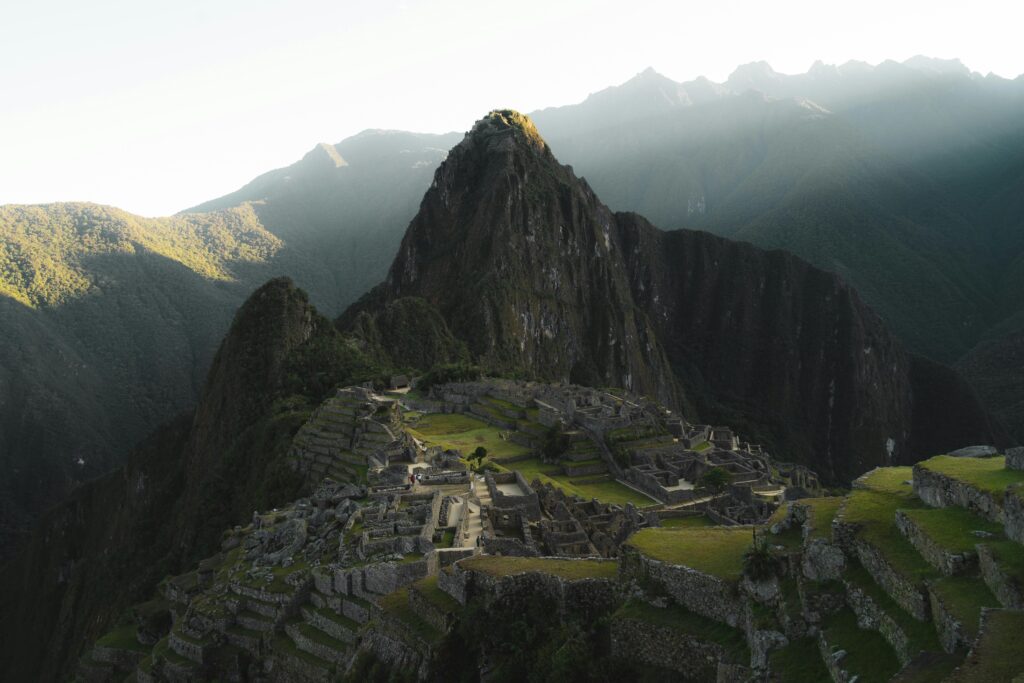The Inca Trail in Peru is one of the most famous hiking routes in the world, leading to the awe-inspiring ancient city of Machu Picchu. This historic trail, once used by the Incas, offers a unique combination of breath-taking natural beauty, ancient ruins, and cultural heritage.
Overview and History
The Inca Trail is part of an extensive network of trails built by the Inca civilization over 500 years ago. The trail stretches approximately 43 kilometres (26 miles) through the Andes Mountains, starting near the town of Ollantaytambo and culminating at the Sun Gate (Inti Punku) of Machu Picchu. The trail was originally used for religious pilgrimages and as a route for messengers, traders, and armies.

The Route
The classic Inca Trail trek typically takes four days and three nights, although shorter variations are available. Here’s a day-by-day breakdown of the classic route:
Day 1: Km 82 to Wayllabamba
- Distance: 12 km (7.5 miles)
- Elevation: 2,600 m (8,530 ft) to 3,000 m (9,842 ft)
- Highlights: The journey begins at Km 82, where hikers cross the Vilcanota River and pass through the small village of Miskay. The trail ascends gently, offering views of the snow-capped peak of Veronica Mountain. Along the way, trekkers visit the archaeological site of Patallacta, an ancient Incan town.
Day 2: Wayllabamba to Pacaymayo
- Distance: 11 km (6.8 miles)
- Elevation: 3,000 m (9,842 ft) to 3,600 m (11,811 ft)
- Highlights: This is the most challenging day, featuring a steep ascent to the highest point of the trail, Dead Woman’s Pass (Warmiwañusqa), at 4,200 m (13,779 ft). The pass offers stunning panoramic views of the surrounding mountains. After the pass, the trail descends into the Pacaymayo Valley, where hikers camp for the night.
Day 3: Pacaymayo to Wiñay Wayna
- Distance: 16 km (9.9 miles)
- Elevation: 3,600 m (11,811 ft) to 2,650 m (8,694 ft)
- Highlights: This day is rich in archaeological sites. Trekkers first climb to the second pass, Runkurakay, at 3,950 m (12,959 ft), then descend to the ruins of Sayacmarca. The trail continues through a cloud forest, passing the impressive ruins of Phuyupatamarca and finally reaching the beautiful terraces of Wiñay Wayna.
Day 4: Wiñay Wayna to Machu Picchu
- Distance: 4 km (2.5 miles)
- Elevation: 2,650 m (8,694 ft) to 2,430 m (7,972 ft)
- Highlights: The final day begins early, with a pre-dawn hike to reach the Sun Gate (Inti Punku) at sunrise. From the Sun Gate, hikers get their first glimpse of the iconic ruins of Machu Picchu, bathed in the morning light. The trail then descends into the ancient city, where trekkers can explore its magnificent stone structures and terraces.
Ecosystems and Scenery
The Inca Trail traverses diverse ecosystems, ranging from high Andean plains to lush cloud forests. Hikers experience a variety of landscapes, including:
- High-altitude tundra: Featuring hardy grasses and shrubs.
- Cloud forests: Teeming with orchids, ferns, and bromeliads.
- Subtropical jungle: With a rich array of flora and fauna.
The trail offers stunning views of snow-capped peaks, deep valleys, and verdant forests, making it a visual feast for nature lovers.
Archaeological Sites
In addition to Machu Picchu, the trail passes several significant Inca sites, each offering insights into the civilization’s engineering prowess and cultural practices:
- Patallacta: An agricultural and administrative site with terraced fields.
- Runkurakay: A circular ruin believed to be a rest stop for messengers.
- Sayacmarca: A fortress with a strategic vantage point over the valley.
- Phuyupatamarca: Known as the “Town in the Clouds,” featuring intricate stonework and water channels.
- Wiñay Wayna: A beautiful complex with terraces, fountains, and temples.
Permits and Regulations
To protect the trail and its surroundings, the Peruvian government limits the number of trekkers to 500 per day, including guides and porters. As a result, permits are required and must be booked well in advance, often six months ahead of the desired trek date. The trail is closed each February for maintenance.
Conclusion
The Inca Trail is not just a hike; it’s a journey through history and nature, offering an unforgettable experience for those who take on its challenges. With its combination of stunning landscapes, rich biodiversity, and significant archaeological sites, the Inca Trail remains one of the world’s premier trekking adventures.